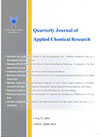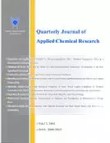فهرست مطالب

Journal of Applied Chemical Research
Volume:12 Issue: 4, Autumn 2018
- تاریخ انتشار: 1397/09/12
- تعداد عناوین: 8
-
-
Pages 8-20In this work, H3PW12O40 (PPT) and nano-sized titania supported on urea formaldehyde (UF) resin was prepared via an impregnation method. The prepared sample was characterized by X-ray diffraction (XRD), UV-Vis spectrophotometer, Fourier transform infrared spectroscopy (FT-IR), scanning electron microscopy (SEM) and energy-dispersive X-ray spectroscopy (EDX). The photo catalytic activity of the PPT/TiO2/UF sample was evaluated by the decolorization of Bromothymol Blue (BB), Direct Yellow12 (DY) and Texas Red (TR) dye solutions under UV-Vis and visible light irradiation. The optical property of the PPT/TiO2/UF sample was evaluated by UV-Vis spectrum. The effect of photocatalyst dosage and dye concentration on photo catalytic decolorization of dyes was investigated. Photo catalytic efficiency of the PPT/TiO2/UF sample was compared with TiO2/UF sample. Moreover, the reusability of the sample was examined.Keywords: Composite, H3PW12O40, Photo Catalyst, TiO2, Urea formaldehyde
-
Pages 21-30The corrosion inhibition potential and efficacy of 2-hydropyrimidine-2-thione derivative on mild steel in 0.5 M sulfuric acid solution was investigated using electrochemical polarization and FTIR spectroscopic techniques. In addition, docking studies were carried out as theoretical investigation of adsorption inhibitor on iron surface. The results of polarization studies indicate the exceptionally strong efficiency of this compound as an inhibitor in H2SO4 solution. The electrochemical studies to elucidate the mechanism indicated adsorption obeying the Langmuir isotherm to be the main mode of action. The FTIR results indicated the presence of inhibitor molecules to formation protective layer on the surface of mild steel. Theoretical findings show that the most stable states of compound/iron system are via the molecular sites containing S atoms, ester groups and aromatic rings.Keywords: Corrosion Inhibitor, Sulfuric Acid, 2-Hydropyrimidine-2-Thione Derivative, Potentiostatic polarization, Docking Technique
-
Pages 31-41An efficient one-pot four-component protocol for the synthesis of pyrano[2,3-c]pyrazole derivatives has been demonstrated using Y(NO3)3.6H2O as catalyst under mild condition. This is a general synthetic protocol which could be applicable to a wide range of carbonyl compounds including aromatic aldehydes, isatins and acenaphthenequinone. All The reactions proceeded smoothly, high-yielding and purity via an easy work-up procedure.Keywords: Pyranopyrazoles, Spiro[indoline-3, Spiro[acenaphthylene-1, 4-pyrano[2, 3-c]pyrazole]
-
Pages 42-50In this work, growth and assembly of the micro polyhedral zinc oxide was performed using air bubble assisted Triton X100, as a templating agent. In absence of air bubbling in the reaction system the nano plate zinc oxide was synthesized. The prepared samples were characterized by Xray diffraction (XRD), field emission scanning electron microscopy (FE-SEM) and UV-Vis spectrophotometer. The optical properties of the samples were evaluated by UV-Vis spectrum. Photocatalytic application of the samples for simultaneous decolorization of methylene blue (MB) and methyl orange (MO) dyes mixture in aqueous solution was examined. The Langmuir- Hinshelwood model for decolorization kinetic data was investigated. The reusability of the samples after five consecutive uses was examined. The photocatalytic results indicated that the micro polyhedral zinc oxide is a promising candidate for simultaneous decolorization of the MO and MB dyes (>90%).Keywords: Micro polyhedral, Nano plate, Photocatalyst, Triton X100, Zinc oxide
-
Pages 51-65In the paper, in order to pre-concentrate and measure the low values of Cu ions, the new, simple, quick and very sensitive method of Dispersed Liquid-Liquid Micro Extraction (DLLME) coupled with flame Atomic Absorption spectrometry (AA) has been utilized. The DLLME technique coupled with AA )AA-DLLME) was run inside one narrow tube which constitute aqueous samples. In this method, a mixture of toluene and methanol 90:10 (v/v) was injected into the aqueous sample as extractor and disperser agent and then Cu and diethyldithiocarbamate (DDTC) complex was concentrated inside the toluene and was collected on the sample solution. In order to optimize the factors affecting on the process, different parameters affected on the Cu extraction such as kind and volume of extractor, volume of dispersing solvent, pH of sample solution, ligand concentration, time for bubble formation and salt effect were studied. Under optimal condition, limit of detection (LOD), relative standard deviation (RSD) and limit of linearity (LOL) for calibration curve were measured and were obtained as: 1.2 μg.l-1, 3.64% and 0.01-1 mg.l-1, respectively. This method was successfully applied to determine Cu in environmental waters, milk powder, liquid milk and orange juice.Keywords: Microextraction, Pre-concentration, Copper, DLLME
-
Pages 66-77In this research, novel conductive nanocomposites containing urethane acrylate (UA) and polyaniline/copper (II) oxide nanocomposites (PANi-CuO) were synthesized. At first polyaniline/CuO nanocomposites with different amount of CuOnanoparticleswere prepared by chemical oxidationpolymerization of aniline using ammonium peroxydisulfate as an oxidizing agent. Afterward, UA-PANi-CuO nanocomposites were mixed and then cured by ultraviolet irradiation. Analytical tests (FTIR and UV–vis spectroscopy, X-ray diffraction) approved chemical structure of synthesized materials. The SEM images of the nanocomposites showed uniform distribution of CuO nanoparticles in PANi matrix and UA-PANi-CuO in urethane acrylate matrix. Electrical conductivity measurements of PANi-CuO nanocomposites revealed that the conductivity of PANi decreased with adding content of CuO nanoparticles, also the conductivity of UA increased with adding PANi-CuO.Keywords: Polyaniline, CuO nanoparticles, UV cure, Urethane acrylate, Electrical conductivity
-
Pages 78-862-Methylpyridinum p-toluenesulfonate ([2-MPy][p-TSA]) as a novel room temperature ionic liquid was synthesized and evaluated as a recoverable catalyst for the one-pot synthesis of hexahydroquinoline-3-carboxamide derivatives by four-component reaction of arylaldehydes, dimedone, acetoacetanilide and ammonium acetate in high to excellent yield in ethanol at 50 oC. The [2-MPy][p-TSA] catalyst was characterized via FT-IR, 1H NMR and 13C NMR spectroscopy. An environmentally benign procedure, four-component in one pot reaction, high yields and simple preparation of the catalyst are some advantages of this work.Keywords: 2-Methylpyridinum p-toluenesulfonate, Ionic liquid, One-pot reaction, Hexahydroquinoline-3-carboxamide
-
Pages 87-97In this study, 2-aminobenzoic acid (ABA) has been used as complexing ligand for simultaneous determination of metal ions by adsorptive cathodic stripping voltammetry (AdCSV), for the first time. Thus, a selective and sensitive procedure was presented for simultaneous determination of lead, cadmium and nickel using ABA and differential pulse-adsorptive cathodic stripping voltammetry (DP-AdCSV). The method was based on adsorptive accumulation of the complexes of Pb(II), Cd(II) and Ni(II) ions with ABA onto hanging mercury drop electrode (HMDE), followed by reduction of adsorbed species by differential pulse cathodic stripping voltammetry. The effect of experimental parameters such as pH, ABA concentration, accumulation time and potentialand scan rate on the electrode response was examined. Under the optimized conditions, linear calibration curves were established for the concentration of Pb(II), Cd(II) and Ni(II) in the ranges of 5-150, 5- 120 and 5-150 ng mL-1, respectively. Detection limits of 1.78, 2.26 and 1.78 ng mL-1 were obtained for Pb(II), Cd(II) and Ni(II), respectively. An application of the proposed method was reported for determination of these elements in tap water and industrial waste water of as real samples.Keywords: 2-aminobenzoic acid, heavy metals, Adsorptive cathodic stripping voltammetry, Water Samples


